Blog →
Blog →

by
Philippe Lehoux
September 14, 2020
· Updated on
Update: Now blocking read receipts from other services. Missive now auto blocks read trackers and 1x1 images to prevent senders from spying on what you do with their email.
This week we sunsetted read receipts from Missive. This will cost us a lot, so here is why we did it.
Read tracking is magical. You know instantly when your recipients open your sent emails. This brings incredible power and can be beneficial in many legitimate business scenarios. It’s really popular.
Behind the scenes however, there is an uglier untold story. For us, the technologists who built and offered support around it, it kept getting more controversial over time. In the most extreme cases, we saw first hand how it was misused and weaponized to abuse people. And on the more innocuous and potentially useful scenarios, how unreliable it could be, which could in the end give a false sense of control to our users. A technology that works 70% of the time is a bad one.
Missive is a team communication app. From day one, we believed that in order to succeed we had to offer an unparalleled email experience. Email is the most important channel in most business communication stacks.
For instance, sales people live and die in their email clients. One really useful feature for them is read tracking. You send an email to a prospect, that person quickly follows up saying they are not interested, but 3 months later, they reopen that same email, you get a live read notification, you instantly take your phone and follow up. You win.
After we launched Missive in 2015, requests for a read tracking feature quickly started to pile up.
We built it.
When you advertise read tracking ability, the majority of users don't think about the intrinsic aspect of it, how it works and how unreliable it can be. They expect it to work all the time.
Behind the scenes, read tracking works by checking if an image in the sent email has been requested on a server. Each recipient receives a different version of the email with a unique transparent image. Each time one of those images is requested, the server matches it to a recipient and notifies the sender.
But… false positives and false negatives are very common:
When a user expects read tracking to be a source of truth, those false positives/negatives can cause weird situations.
There is no way to make this more reliable. All apps offering read tracking ability without explicitly mentioning to their users that it sucks, are doing false advertisement.
Now, a lot of educated users know the pitfalls of the technology, and use it with a grain of salt. From our support experience however, those are the minority.
With a minimal amount of creativity, it’s easy to come up with scenarios where people can misuse read tracking.
Let’s say you received a love letter (email) from a colleague, you are quite moved and touched by it, but feel it’s inappropriate and decide to not reply. But the words haunt you and you go back and read them again and again.
Now, if the love letter author inserted a pixel tracker, they can know every single time you did go back to that email, and read it again and again. Not cool.
This scenario is fantasy, I just came up with it. But for us, no need to be to creative, people would write us messages like:

Argh… no! Please, don’t do that with our product, please.
We are no legal experts, but for us, it seems clear offering read tracking ability made us ride on the grey side of privacy laws like GDPR.
[... referring to email tracking … ] The data processing is secretly performed, i.e. no information about the data processing is provided to the email recipients from whom the data is retrieved. Furthermore, email recipients are not given the possibility to accept or refuse the retrieval of the information described above. In sum, differently from classical acknowledgement email systems, with these new products, the recipient of emails has no possibility to accept or refuse the acknowledgment information processing towards the software user.
The Working Party 29 expresses the strongest opposition to this processing because personal data about addressees’ behaviour are recorded and transmitted without an unambiguous consent of a relevant addressee. This processing, performed secretly, is contradictory to the data protection principles requiring loyalty and transparency in the collection of personal data, provided by Article 10 of the Data Protection Directive.
-European data protection authorities opinion on email tracking.
You can do mental gymnastics, but read tracking is a predatory feature, privacy wise. Is it legal for a provider like Missive to offer email tracking capacity? Is the burden of using it all on our customers’ shoulders?
This is all debatable, and a lot of our users, when preemptively announced we would retire read tracking, argued that many other apps (CRM, email clients, etc) still offered it.
For instance, Superhuman when faced with controversy for offering read tracking made it opt-in instead of opt-out, probably for that exact reason.
The major difference between us and them is size. Being legally challenged in court or fined would most certainly be a death blow for a small bootstrapped company. Not a risk we are willing to take.
Our competitor funded with hundreds of millions of dollars from Silicon Valley can certainly foot the legal bills, not us.
To summarize, read tracking doesn’t really work, can be weaponized, is most certainly illegal in many places and is potentially deadly to our business. Pulling the plug seemed obvious to the four of us.
This will affect our bottom line, some of our users will leave for competitors*. But today, we took a stance and it feels good.
And to end this post on a high note. We want to officially announce that we're actively working on a full-fledged calendar in Missive! You will be able to accept invites, add events and alerts, share calendars, and more! We estimate that it will be ready in under two months.
* If you are one of those users who cancel their Missive account, we offer to refund your last payment. Just contact us by email by October 15th, 2020.

January 5, 2026
What we released in 2025
Looking back at 2025, we doubled the size of our team and set out to tackle some of the most requested features from our users.
Each year gives us 365 days to make Missive better for you, our users. I'm excited for 2026 and I'm incredibly proud of what we accomplished in the last 365 days.
Looking back at 2025, we doubled the size of our team and set out to tackle some of the most requested features from our users. We also shipped a handful of improvements that quietly make everyone’s day‑to‑day work in Missive smoother.
Here are some highlights from our favorite releases this year.
This year we introduced AI-powered rules that let automations understand message content rather than rely on static conditions. We expanded them with multi-channel support, model selection, and practical actions like AI labeling, draft creation, and pre-send checks for outgoing messages, making rules more useful in day-to-day workflows.
Rules also became easier to manage with drag-and-drop editing, support for signatures in rule-generated drafts, and the ability to remove users from conversations automatically.
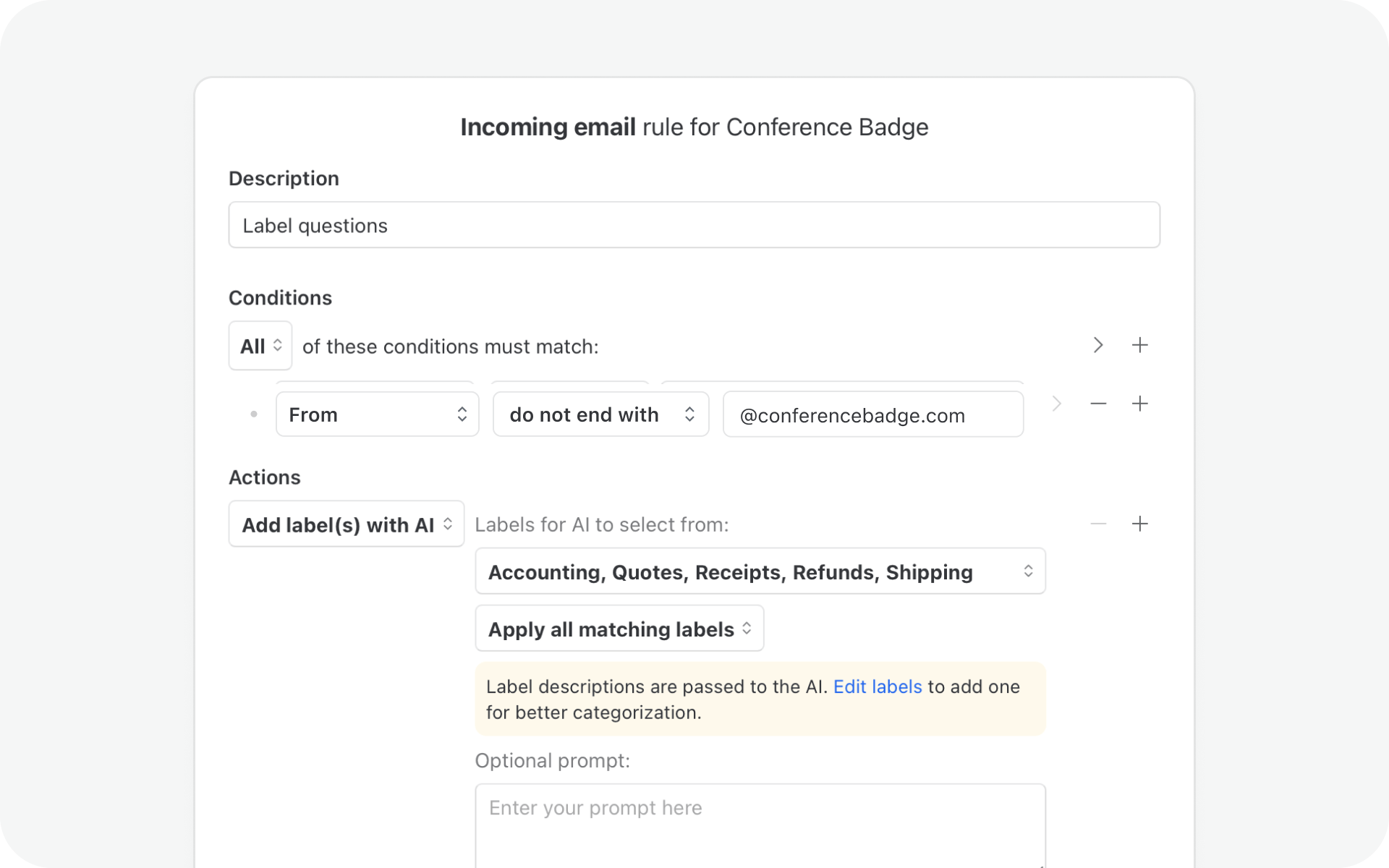
We’ve completely re-imagined how tasks work in Missive. You’ll now find dedicated views that brings together all your tasks into one place.

We added search and filter options to make it easier and more efficient to find the information you need. Filters with a specific date range, domain names, only conversations with attachments, etc.

See all files and attachments from any conversation in one unified view. Cleaner thumbnails, category-based organization, and Quick Look with keyboard shortcuts make everyday tasks faster.

Taking a well-deserved break? You can now set up automatic replies for your personal accounts right from your out of office status, no need for a rule.
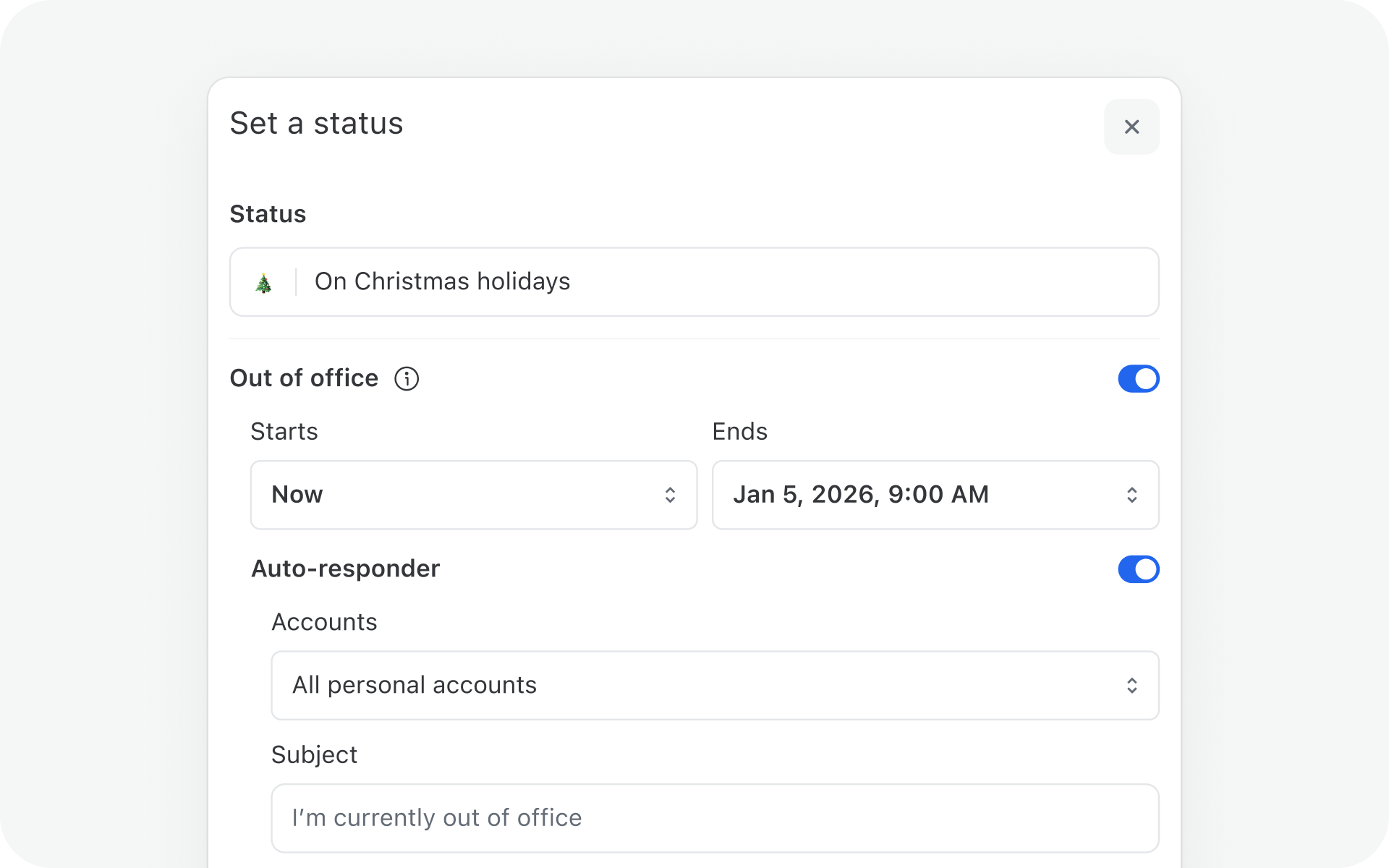
No more forwarding long threads or stitching together feedback from different tools. Guest Access lets you bring people outside your organization, like an accountant, contractor, or client—directly into specific Missive conversations.

You can now toggle your Drafts and Sent mailboxes to show only the conversations with messages you personally created or all the ones from your colleagues, making it easier to focus on your own work.
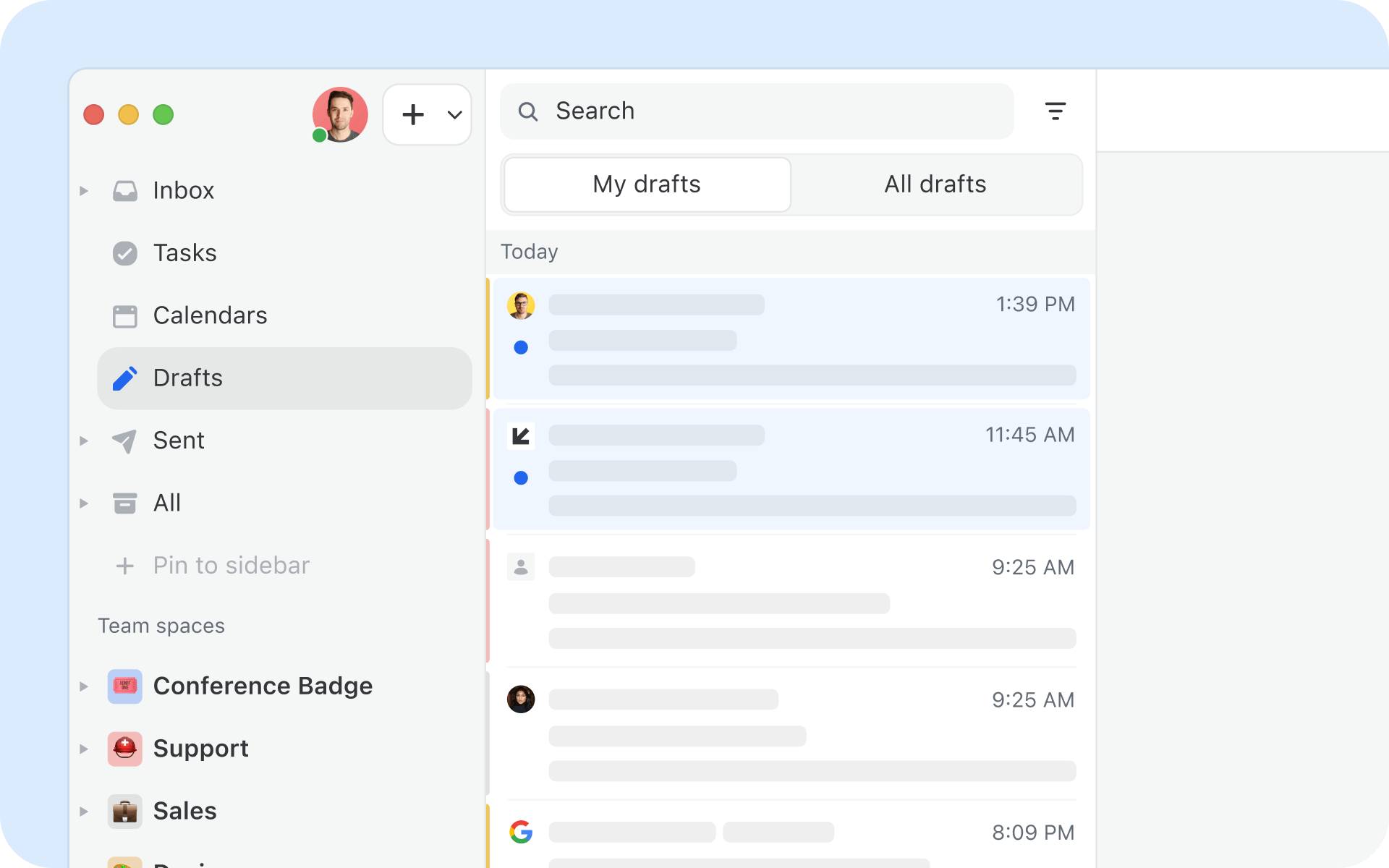
We redesigned our signup and onboarding flow to better guide new organizations through their first steps, with clearer hand-holding around creating a team and connecting a first shared account.
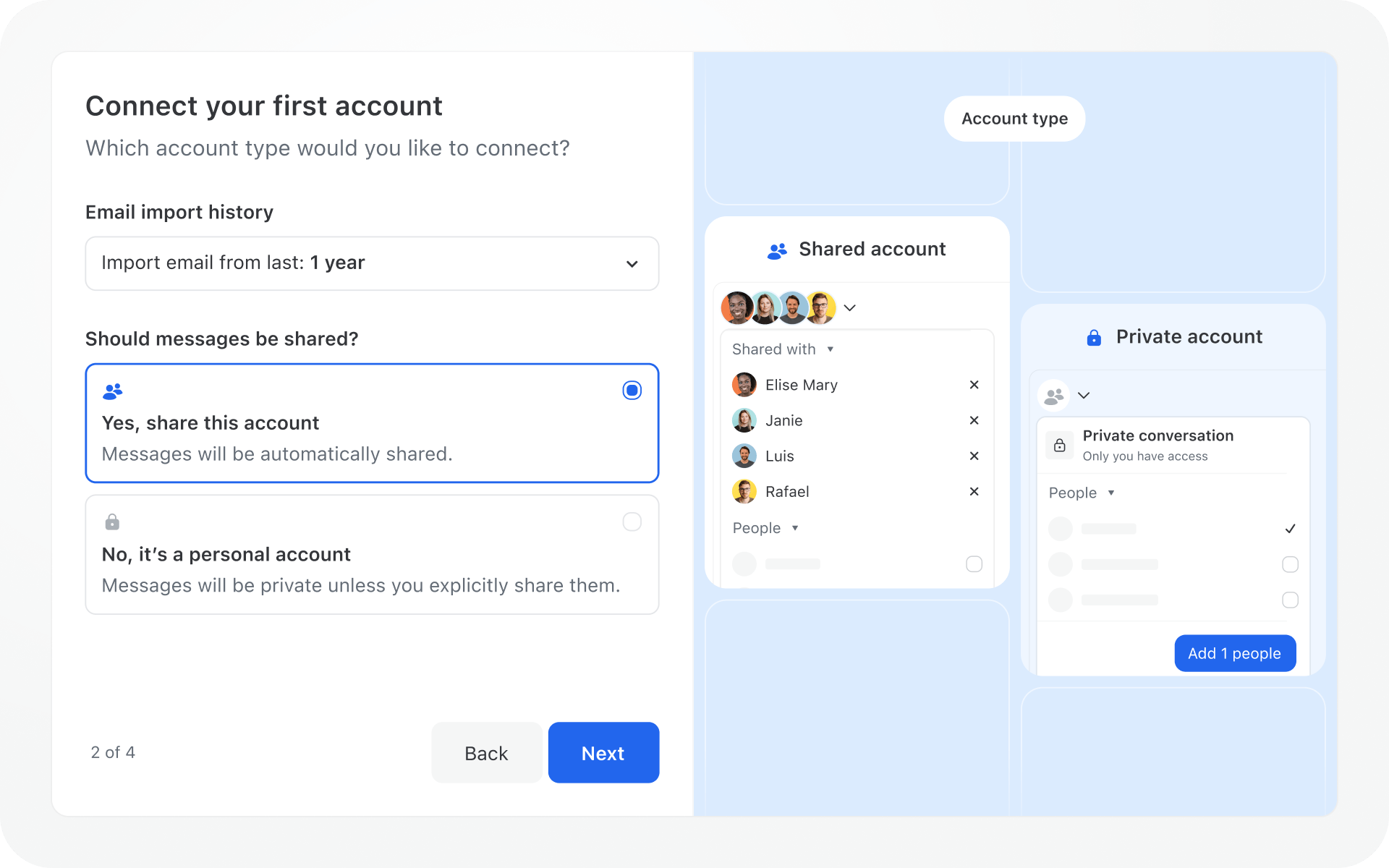
A new way to organize your teams. Every team has now a dedicated space in the sidebar, and every member will see the right elements depending on their role in the team. Quickly access your team’s inbox, Tasks, and Chatroom from the same place.
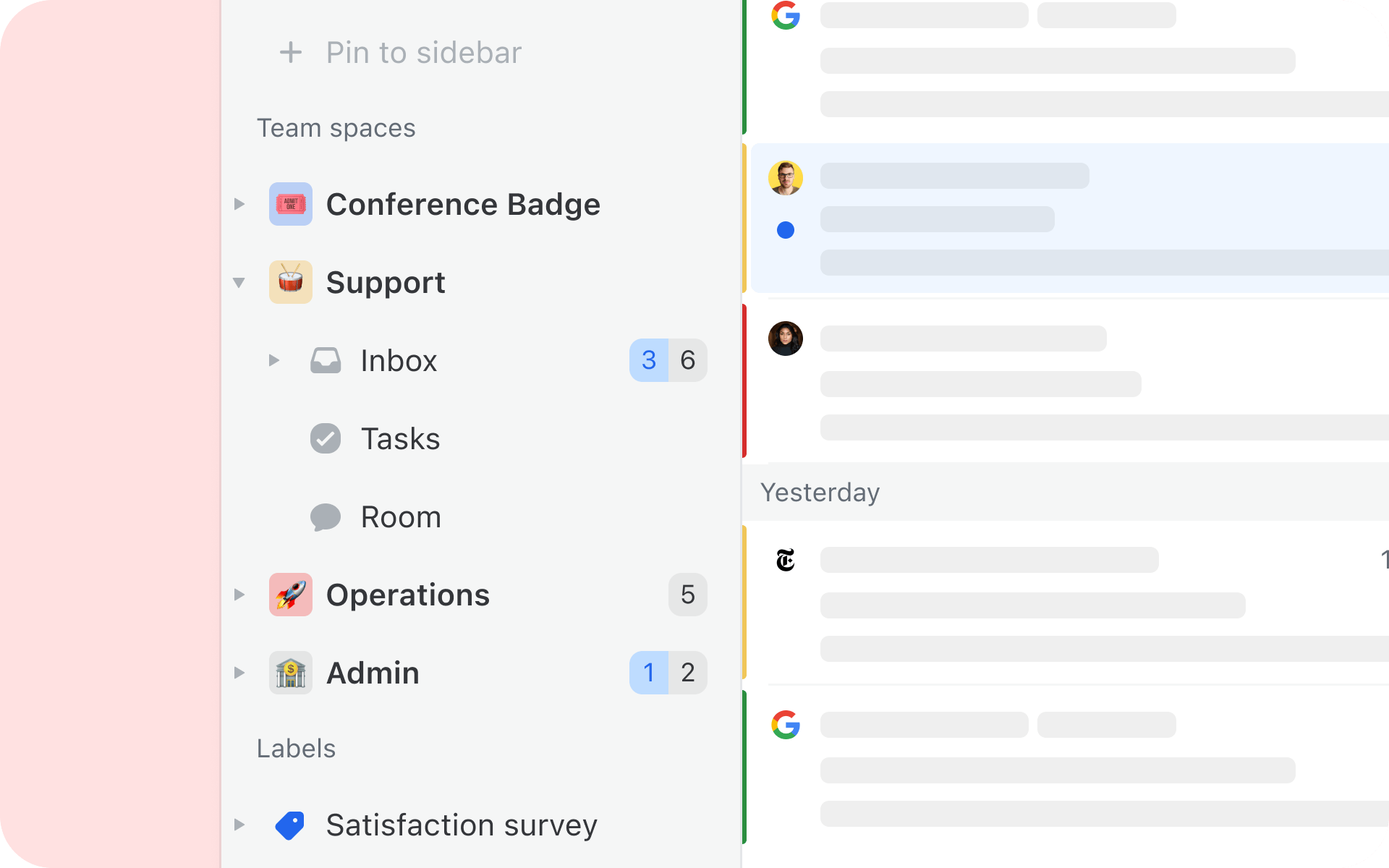
Native support for WhatsApp Business. No need to add a WhatsApp account via a third-party provider anymore, import directly from Facebook Business Manager.
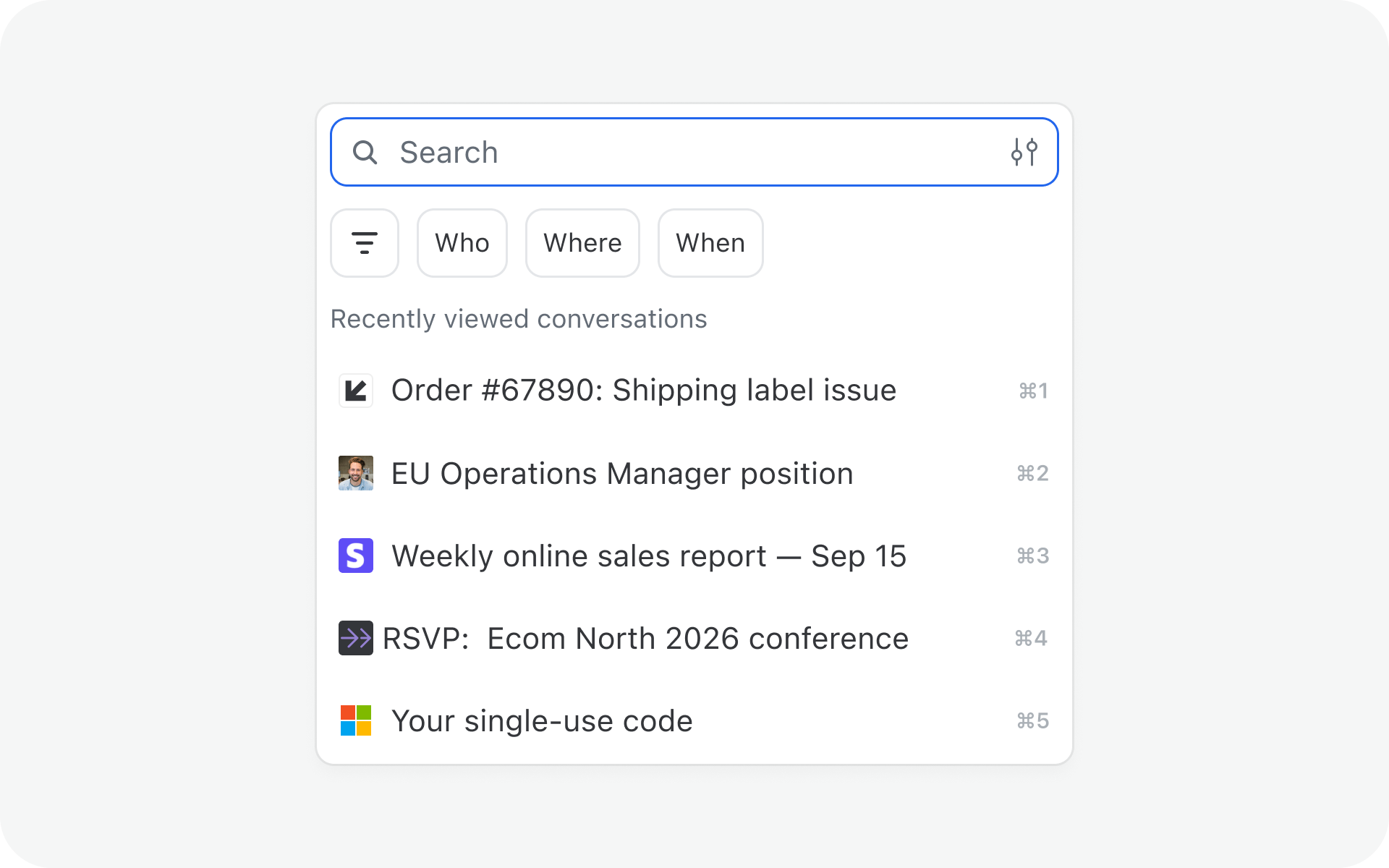

As always, we'll be regularly shipping improvements and posting them on our changelog. We can't wait to show you what we're cooking up in 2026 already.

October 1, 2024
A Decade of Lazy Marketing
A look back at the marketing efforts that fueled Missive's growth over the past 10 years.
When talking about Missive, I often dropped this bomb:
— We never did any marketing.
Well, looking back, it’s a lie. Or let’s just say that it’s an understatement.
Or maybe I was being lazy and not recollecting the many small things we did.
Now that the Missive team is growing fast (read more), I realized, you must tell your team the complete story to equip them with success.
I’m writing this for our future Head of marketing. It’s a list of all of the things we did marketing-wise for the last ten-ish years. As you can see, not so much.
To me it's a testament that, yes, if you build something that people like, they will find you.
Now, imagine with a marketing team...
Note: We got our first customer on Jul. 20, 2016 and we are now at ~$500k USD MRR eight years later.

1. First homepage, at this point Missive was free to use beta. 2015

2. We have a Blog we updated sporadically. 2015 - 2024
3. Multiple ProductHunt launches. 2015-2023

4. A Brief History of Email Apps. - A failed attempt at creating valuable content. Was fun to do, but was a miserable failure. 2015

5. Twitter - Hello Word 2015

6. Email cold outreach to a few people we admired to get feedback and validate the product. No more than 50 emails total were sent. 2015

7. Second homepage and the release of our paid plans. 2016

8. Twitter - I monitored conversations about competitors, email clients, etc. and mentioned Missive in replies. 2016-2023

9. Nailed basic SEO vitals. 2016-2024

10. Open sourced EmojiMart component, now used by big startups (e.g. Figma!). It's a big driver of traffic and backlinks. 2016-2024

11. Attending the Inbox Awesome conference in NYC, the conference was for email marketers, not our target audience. Here is a picture of me on a panel about how to make people open and read your email newsletters. I had 0 clue what I was doing. I attended two years in a row because we like the title "Inbox Awesome" 🤣. 2016-2017

12. Getting both our desktop and mobile javascript apps featured on the App Store and writing about it. This established us as a legitimate player in the email client space. 2017

13. Published VS competitor landing pages, to this day, these are our most valuable content. 2016-2024

14. Developed integrations with popular SaaS (Asana, Salesforce, Aircall, etc.). This created nice co-marketing opportunities like being featured in their app/integration store. 2019-2023

15. Third homepage (current one). 2020

16. We deprecated a really popular feature, read tracking, we explained our reasoning in a blog post. This was an important decision, it helped defined our company culture and product direction. It mostly created churn for solo-user customers.
17. We hired consultants to do SEO + write content. We did with two firms, both times the firm owners were paid Missive users. In both instances we paid $10k/month and the experiment went on for around six months. Six months is not a lot in the SEO world, but each time, both we and the consultant learned that writing good content on an app like Missive is really hard and can't be done by pay-to-hire-content-writers. 2022 & 2024
18. We ditched Google analytics, for privacy reasons, read more. I'm still not so sure about this one, it does feel like we did some privacy-posturing. Now, this might be a potential friction for our future marketing team. We have no plan to re-visit this at the moment.
19. We created a homemade affiliate program. 2022 - 2024

20. MRR milestone blog posts + Hacker news traffic 2021-2024


21. We created many case studies to showcase how Missive is used by people in different industries. Those were pushed on LinkedIn and X.2020-2023

22. We sent a total of forty newsletters, all were a summary of our progress pushing out the content of our changelog. 2016-2024

23. We offer weekly webinars potential customers can attend to learn more about the product and each webinar offers a dedicated Q&A at the end. Those webinars have been a great success, specially for people coming from other competitors looking for a validation that the switch to Missive is a good decision. 2020 - 2024

24. We attended our first trade show in an industry where we find some of our bigger customers, logistic companies. I wrote an article about our experience. 2024

25. We got serious with G2 and other review sites and started earning multiple customer reviews and earning multiple badges. 2024

26. All co-founders did couple of podcasts & interviews over the years. (1, 2, 3, 4, 5, 6, 7, 8, ...) 2016 - 2024
27. I developed our product metric pipeline with Segment and Mixpanel. This will be useful for the future marketing team. 2024

This list is really a testament of how small our team was and how focused on the product we were. We were lucky enough those small initiatives created enough traction to where we are today. Having said that, reading it again, it shows unequivocally how amateurish our marketing efforts were.
It's time to bring expertise and structure, our marketing efforts should be as good as the quality of our product. And thus, we are looking for a Head of Marketing. If you are interested, please reach out (email).